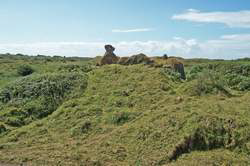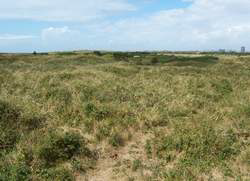Abandoned Communities ..... Kenfig
For two hundred years between the middle of the twelfth century and the middle of the fourteenth century the town of Kenfig was a thriving community. Then the sand started to arrive. By the time another hundred years had passed nearly everyone living in Kenfig had moved out. When John Leland, sometimes described as the first English antiquary, travelled through South Wales in 1539 he saw a village on the east side of the River Kenfig and a castle, both in ruins and almost choked and devoured with the sands that the Severn Sea casteth up.
I will talk later about the fate inflicted on Kenfig by the Severn Sea. First I want to give you an impression of what sort of place it was and the way of life of the people living there.
We cannot be certain how Kenfig was created, but it appears to have been founded around 1140 by Robert, Earl of Gloucester. At that time the Norman conquest of England was more or less complete, but the Normans were meeting much stiffer resistance in Wales. Robert, Earl of Gloucester was a son, albeit illegitimate, of King Henry I. Among his possessions he held the Lordship of Glamorgan. While Glamorgan had been largely subdued its western end was far from peaceful. The castle and town of Kenfig were therefore founded in order to establish greater control over the local people and in particular to secure the crossing of the River Kenfig. The town began as a small community within the outer defences of the castle, but soon developed outside the castle towards the south west, the direction of the sea.
Kenfig was a borough as well as a town. Its most significant residents were the burgesses, each of whom occupied a smallholding known as a burgage. Except in exceptional circumstances burgesses would have been men. In 1349 there were 144 burgesses. If you take into account their families, residents of lower status, members of the clergy, and the garrison of the castle itself then its population at this time can be estimated at about a thousand. As such it would have been one of the five or six largest towns in Glamorgan.
For more information about systems of administration at this time see Helen Jewell, English Local Administration in the Middle Ages, David & Charles, 1972. The form of governance in operation at Kenfig is described in Barrie Griffiths’ book The First Borough of Kenfig 1147-1439, The Kenfig Society, 2011, especially pp 133-138.
Rights and privileges were granted to burgesses by means of charters issued by the Lord of Glamorgan. The earliest surviving charter was written in 1397, when the Lord of Glamorgan was Thomas le Despenser. You can see it in the Glamorgan Record Office in Cardiff. A member of staff will bring it to you and open the folder in which it is contained. The staff member will then untie the ribbon of a small box, open the box, and reveal the charter's seal. You will need to have a very good grasp of medieval Latin to understand the charter.
Among the rights conferred upon the burgesses by the 1397 charter were:
• The right to elect three bailiffs from among themselves each year, one of whom was required to assist the constable of the castle in the administration of the town.
• The right to appoint two ale tasters.
• The right to form a merchant guild for the purpose of controlling the town's trade.
• The right to hold two fairs each year, one starting on the eve of St James (24 July), the other on the Tuesday of Whitsun week.
• Rights to common pasture in defined areas outside the town, together with a small piece of arable land.
In addition to the task of checking the quality of local ales the ale tasters would have had wider responsibilities in relation to the quality control of food and drink being offered for sale.
The charter contains indications that the threat of sand had already begun to make itself felt. The arable land granted to the town and a part of the common pasture were additions to the land previously available to the burgesses. It may have been granted to compensate for land already affected by encroaching sand. In addition the charter refers to a stream known as the Blaklaak which "used to run" from the southern to the northern water of Kenfig. Barrie Griffiths has argued that this is evidence that by 1360 the Blaklaak stream had been covered by sand and no longer ran above ground.
I will talk later about the fate inflicted on Kenfig by the Severn Sea. First I want to give you an impression of what sort of place it was and the way of life of the people living there.
We cannot be certain how Kenfig was created, but it appears to have been founded around 1140 by Robert, Earl of Gloucester. At that time the Norman conquest of England was more or less complete, but the Normans were meeting much stiffer resistance in Wales. Robert, Earl of Gloucester was a son, albeit illegitimate, of King Henry I. Among his possessions he held the Lordship of Glamorgan. While Glamorgan had been largely subdued its western end was far from peaceful. The castle and town of Kenfig were therefore founded in order to establish greater control over the local people and in particular to secure the crossing of the River Kenfig. The town began as a small community within the outer defences of the castle, but soon developed outside the castle towards the south west, the direction of the sea.
Kenfig was a borough as well as a town. Its most significant residents were the burgesses, each of whom occupied a smallholding known as a burgage. Except in exceptional circumstances burgesses would have been men. In 1349 there were 144 burgesses. If you take into account their families, residents of lower status, members of the clergy, and the garrison of the castle itself then its population at this time can be estimated at about a thousand. As such it would have been one of the five or six largest towns in Glamorgan.
For more information about systems of administration at this time see Helen Jewell, English Local Administration in the Middle Ages, David & Charles, 1972. The form of governance in operation at Kenfig is described in Barrie Griffiths’ book The First Borough of Kenfig 1147-
Rights and privileges were granted to burgesses by means of charters issued by the Lord of Glamorgan. The earliest surviving charter was written in 1397, when the Lord of Glamorgan was Thomas le Despenser. You can see it in the Glamorgan Record Office in Cardiff. A member of staff will bring it to you and open the folder in which it is contained. The staff member will then untie the ribbon of a small box, open the box, and reveal the charter's seal. You will need to have a very good grasp of medieval Latin to understand the charter.
Among the rights conferred upon the burgesses by the 1397 charter were:
• The right to elect three bailiffs from among themselves each year, one of whom was required to assist the constable of the castle in the administration of the town.
• The right to appoint two ale tasters.
• The right to form a merchant guild for the purpose of controlling the town's trade.
• The right to hold two fairs each year, one starting on the eve of St James (24 July), the other on the Tuesday of Whitsun week.
• Rights to common pasture in defined areas outside the town, together with a small piece of arable land.
In addition to the task of checking the quality of local ales the ale tasters would have had wider responsibilities in relation to the quality control of food and drink being offered for sale.
The charter contains indications that the threat of sand had already begun to make itself felt. The arable land granted to the town and a part of the common pasture were additions to the land previously available to the burgesses. It may have been granted to compensate for land already affected by encroaching sand. In addition the charter refers to a stream known as the Blaklaak which "used to run" from the southern to the northern water of Kenfig. Barrie Griffiths has argued that this is evidence that by 1360 the Blaklaak stream had been covered by sand and no longer ran above ground.
One
Sand dunes above the town of Kenfig
The keep and inner ward of Kenfig castle
The overmantel in the banqueting hall at Cardiff Castle, with Robert, Earl of Gloucester on horseback. Note the imprisoned head of Duke Robert of Normandy.


